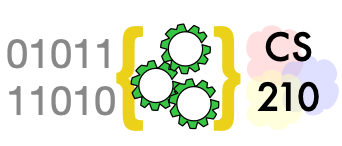Exercises#
Complete the recursive function
subset_sums. Students in Fall 2023 struggled with a version of this problem. See if you can solve it by making use of each of the facts in your recursive solution.
Note that subset_sums(10, [1, 3, 5, 7]) returns True
because \(3+7=10\), and subset_sums(16, [1, 3, 5, 7]) returns
True because \(1+3+5+7=16\), but
subset_sums(12, [2, 3, 5, 8]) returns False
because no subset of the terms 2, 3, 5, and 8 (each used at most
once) sum to 12.
Useful facts:
The sum of zero integers is zero. Thus,
subset_sums(0, t)is always true, butsubset_sums(k, [])is false ifk > 0.It is impossible to obtain a negative number by summing any set of non-negative integers.
If
kis positive, then there are two ways the sumkcould be produced:If
terms[0]is included in the subset that sums tok, then it must be possible to sum the remaining termsterms[1:]tok - terms[0].If
terms[0]is not included in the subset that sums tok, then it must be possible to sum the remaining terms tok.
def subset_sums(k: int, terms: list[int]) -> bool:
"""Return True if it is possible to produce k by adding up
some subset of terms (using each term no more than once).
k is a positive integer or zero, and each element of terms is a
positive integer or zero.
"""
return False # FIXME
print(subset_sums(10, [1, 3, 5, 7]))
# Expect True
print(subset_sums(12, [2, 3, 5, 8]))
# Expect False
Solutions to Exercises#
A solution to
subset_sums. We use the following facts:
The sum of zero integers is zero. Thus,
subset_sums(0, t)is always true (Fact ENOUGH), butsubset_sums(k, [])is false ifk != 0(Fact RAN OUT).It is impossible to obtain a negative number by summing any set of non-negative integers. (Fact NEGATIVE)
If
kis positive, then there are two ways the sumkcould be produced:If
terms[0]is included in the subset that sums tok, then it must be possible to sum the remaining termsterms[1:]tok - terms[0]. (Fact INCLUDE)If
terms[0]is not included in the subset that sums tok, then it must be possible to sum the remaining terms tok. (Fact EXCLUDE)
def subset_sums(k: int, terms: list[int]) -> bool:
"""Return True if it is possible to produce k by adding up
some subset of terms (using each term no more than once).
k is a positive integer or zero, and each element of terms is a
positive integer or zero.
"""
# Case ENOUGH
if k == 0:
return True
# Case RAN OUT
if len(terms) == 0:
return False
# Case NEGATIVE
if k < 0:
return False
# We must have positive k and non-empty terms,
# so INCLUDE and EXCLUDE are the only remaining cases
return (subset_sums(k - terms[0], terms[1:]) # INCLUDE
or subset_sums(k, terms[1:])) # EXCLUDE
print(subset_sums(10, [1, 3, 5, 7]))
# Expect True
print(subset_sums(12, [2, 3, 5, 8]))
# Expect False
True
False

